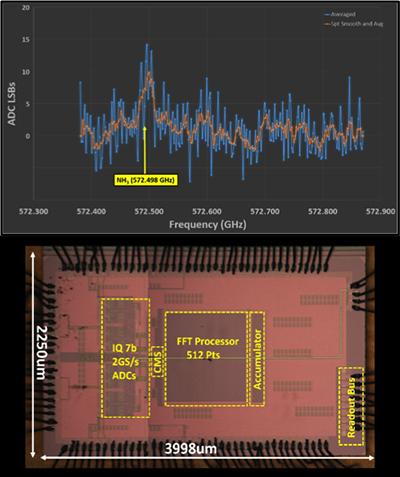
Bottom: Micro-photograph of CMOS Spectrometer Chip.
Jet Propulsion Lab researchers Adrian Tang, Goutam Chattopadhyay, and Brian Drouin in collaboration with UCLA faculty Frank Chang have developed an extremely low-power (less than 0.2 W) wideband spectrometer processor chip capable of detecting trace gases for future NASA instruments. The developed chip uses the same CMOS system-on-chip technology found in smartphones and tablets, allowing the spectrometer processor to be compact, and extremely energy efficient. This efficiency enables future NASA spectrometer instruments to be flown on much smaller platforms (UAVs and cube-satellites) as well as deep space planetary science missions where power and payload size is extremely limited.
The demonstrated spectrometer-chip, occupies only 15 cm3 of volume and weighs less than 200 grams while its GHz-wide bandwidth makes it applicable to a wide range of Earth science, planetary science, and astrophysics applications. The single chip contains a wide range of functions including analog amplification and signal conditioning, calibration functions, analog-to-digital conversion, and signal processing to compute detected chemical spectrums. UCLA graduate students Rod Kim and Li Du and visiting scholar Frank Hsiao also participated in the development of the spectrometer chip.